How One Manufacturer Is Building a Local Talent Pipeline
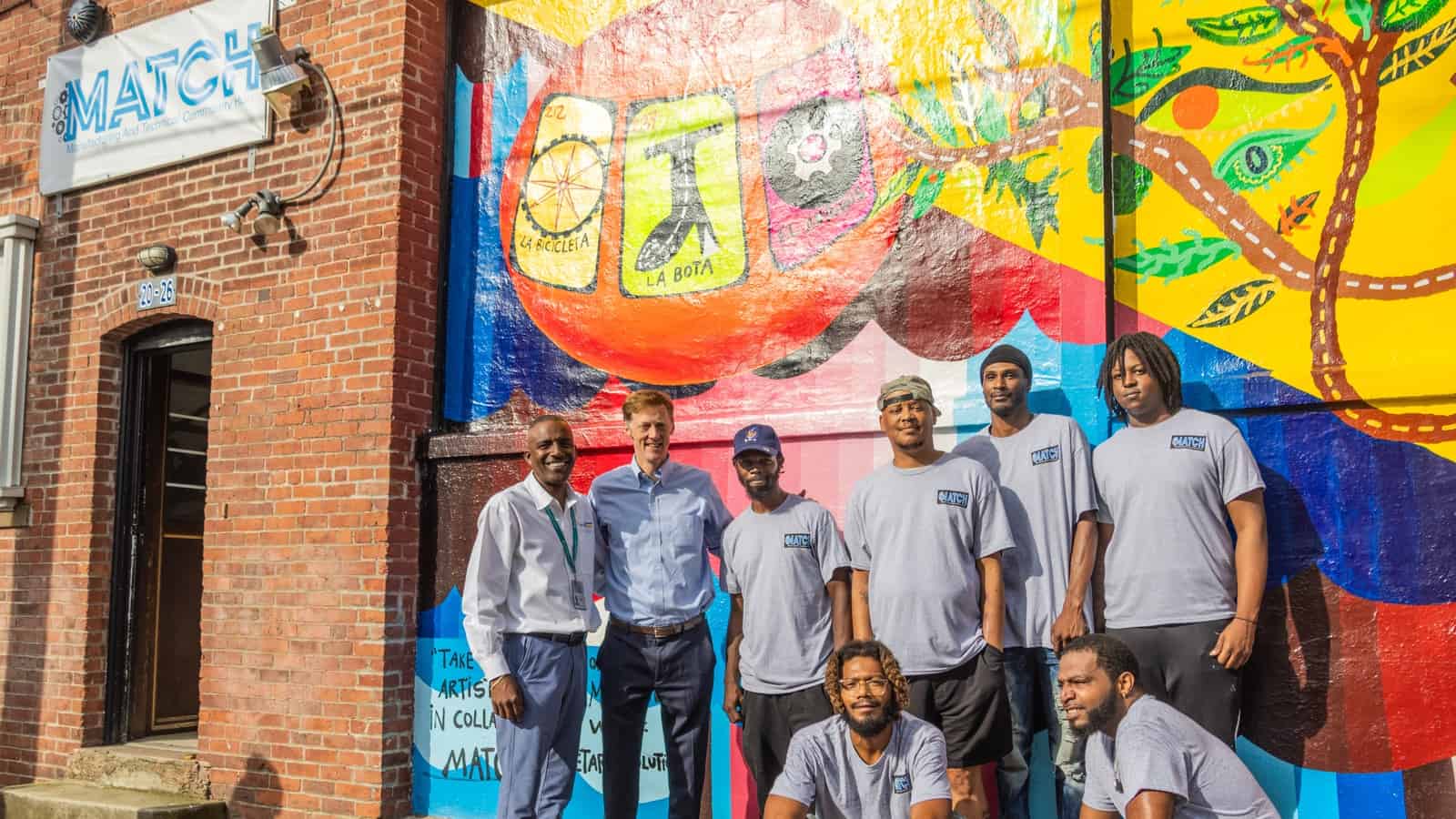
The president of Connecticut-based outdoor lighting manufacturer Penn Globe recently oversaw the launch of a long-awaited passion project: the Manufacturing and Technical Community Hub, or MATCH, a New Haven, Connecticut–area nonprofit contract manufacturing organization and training program designed to fill job openings in the sector.
Seeing a need: “I am a manufacturer, and one of the things I saw missing from the various workforce training programs available was the manufacturers themselves,” LaFemina said. “They weren’t reaching [the participants] in these training programs. So I was a bit frustrated, but that frustration was good … because it led us to create a program with manufacturers training people for actual manufacturing jobs.”
- In 2021, LaFemina and MATCH co-founder Lindy Lee Gold, senior regional manager of the Connecticut Department of Economic and Community Development, secured funding from partners including Lee’s agency, the city of New Haven, the Connecticut Department of Labor and numerous nonprofits.
- This past June, after LaFemina—now MATCH board chair—and the rest of the organization’s board of directors signed a lease on a building, MATCH was born.
How it works: MATCH begins with a two-week, earn-as-you-learn program, offered in both English and Spanish.
- The organization offers training in everything from basic welding to CNC machining, allowing participants to choose the type of manufacturing that interests them most.
- Then, depending on the complexity of their chosen specialty, they may spend up to six additional weeks in paid, on-the-job training before being placed in jobs with local manufacturers.
Meeting the moment: Unlike job-training offerings that expect a certain level of familiarity with an industry, MATCH starts from scratch.
- “Some places say, ‘Let’s test you on something you know nothing about,’” LaFemina told us. “We want to meet the moment. … We’re asking you to come in, give us two weeks and we will pay you minimum wage for the time that you’re here learning.”
- “We’ll figure out what you like and what you’re good at, and as long as we have the workload to make things, you’ll have a job,” she continued.
Being accessible: MATCH also prides itself on seeking out potential employees, instead of waiting to be found.
- “We wanted a building in a specific neighborhood in New Haven,” LaFemina said. “It’s where the majority of the social agencies are, the immigration services, the reentry services. I’d been hearing for two years about how people have [training] programs but couldn’t get participants because [the program locations] were difficult to get to. This one isn’t.”
Family friendly: One of MATCH’s main goals is to reach parents, many of them women, who have left the workforce due to difficulty securing child care. The program’s core hours are 9:00 a.m. to 2:00 p.m., Monday through Friday, in sync with those of most schools.
- MATCH partners are already considering using the program’s New Haven facility as a training site for day care providers, to help alleviate the shortage of workers in that sector.
- In addition, the program’s first cohort of students came from the New Haven Healthy Start’s Fatherhood Involvement project, one of several local initiatives with which the organization has ongoing relationships.
What’s next: MATCH is on track to be financially self-sustaining in three to five years—and LaFemina predicts big growth after that.
- “I see multiple MATCHes down the road,” she said. “There’s already a call for more. My biggest goal is in a few years all of us older people, who leveraged our connections to make this happen, will turn it over to a younger group that will turn it into something even better than it already is.”
How Manufacturing Leaders Are Bolstering Their Cyber Defenses

Cybersecurity threats are increasing, while budgets are getting tighter—so what are C-suites doing about it? The NAM, in partnership with PwC, recently conducted a survey of cyber leaders at manufacturing companies to reveal how they think about their operational security and where they aim to make progress.
Why they do it: When asked why their companies are reinforcing the security of their operational technology, cyber leaders showed that they are thinking deeply about their firms’ long-term development.
- Nearly 50% of respondents said they aimed to defend against ransomware—a smart response, given that 2022 saw almost double the number of ransomware attacks on industrial environments as 2021. Worse yet, 70% of those attacks targeted manufacturers.
- The second most popular answer, however, was the companies’ own internal roadmaps outlining their priorities and technology requirements. This shows how integrated cyber defenses are into companies’ long-term plans; they know that as their operations grow more sophisticated and complex, their cyber defenses have to do so as well.
- Last, cyber leaders also cited the evolution of “Manufacturing 4.0,” as they recognize that the rising sophistication of factories and “smart” technology increases attack surfaces and vectors, therefore requiring smarter and more extensive cybersecurity.
Another positive sign: One of the key indicators of success for cyber leaders is whether their IT teams—which traditionally handle cyber defenses—are in sync with their teams handling operational technology.
- On that score, the survey had good news: more than 30% of respondents said those teams were fully integrated at their companies, and almost 40% said they were partially integrated.
Reporting back: A cyber chief needs to keep the rest of the C-suite and the board informed, but not overwhelmed. So what do they tell other company leaders?
- Nearly 80% of respondents said they give updates on what you might expect: the deployment of technical controls or countermeasures to attacks, as well as progress in implementing their roadmaps.
- About 50% of respondents also said they give updates on security audits, and almost 40% provide reports on compliance with regulations.
In their own words: Several CISOs who reviewed these findings for the NAM explained the reasoning in greater detail:
- One CISO said that “getting into quantitative discussion with boards around risk is hard, so the easier route is to do implementation updates, which provide measurable results.”
- Another CISO said “it’s better to share about what is being done, including patches and roadmaps [than overloading boards with background information].”
Get involved: Are you interested in finding out firsthand how companies handle real cyber challenges? Tell your CISO about the Manufacturing Cybersecurity Advisory Council, a group of CISOs from around the industry who gather every other month for a confidential discussion moderated by the NAM’s COO, Todd Boppell.
- The meetings feature guest speakers, feedback on important issues and discussions of current trends, with a focus on how CISOs at large manufacturers should handle threats throughout the supply chain.
Weigh in: If you’d like to share your company’s own approach to operational technology security, you can take the NAM and PwC’s survey yourself!
Further reading: Lastly, check out PwC’s list of tips for companies looking to beef up their cyber defenses.
Manufacturers to Congress: Restore Pro-Growth Tax Policies Now
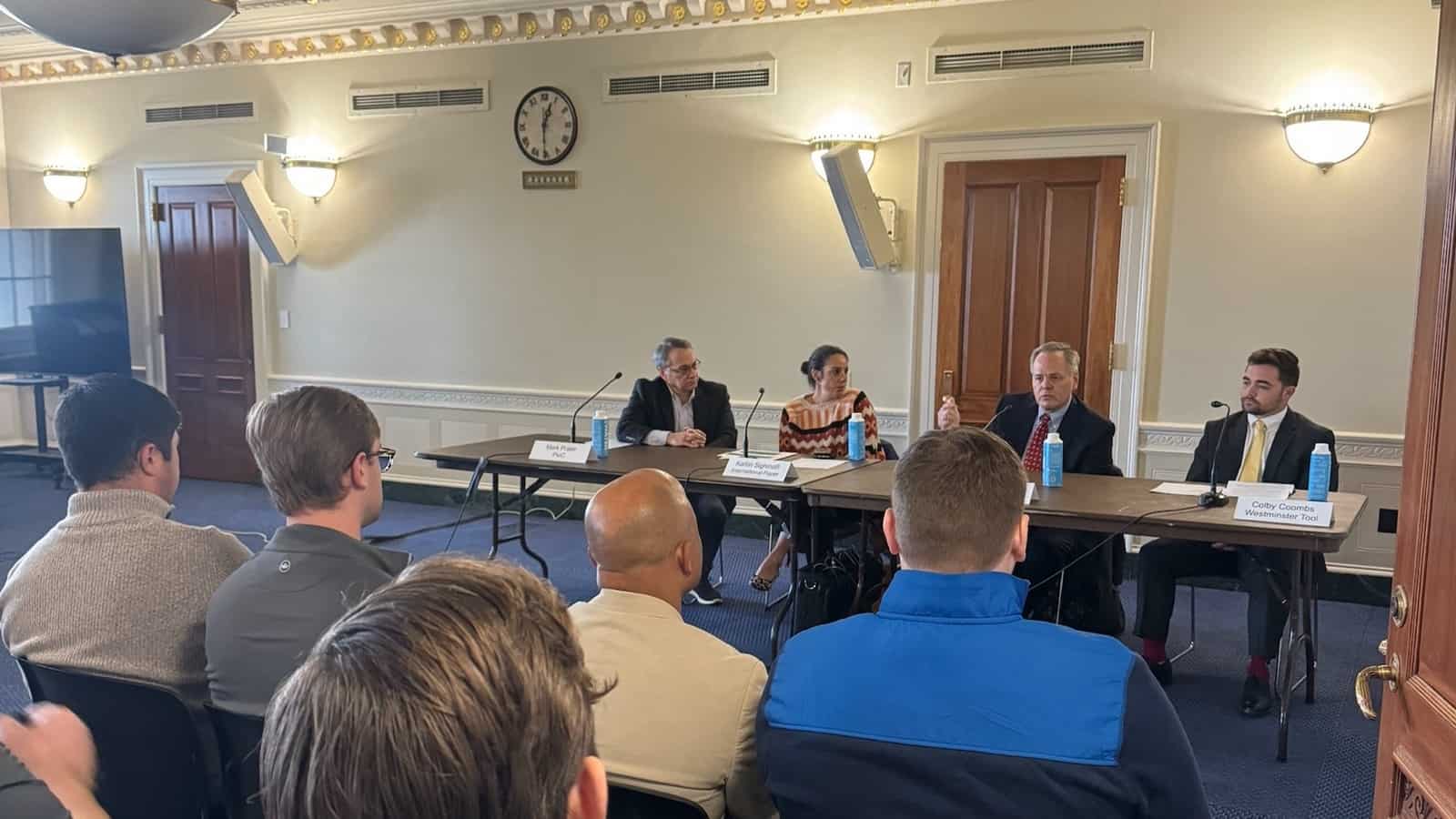
In the third quarter of 2023, private-sector R&D spending fell by 1.2%, according to the Bureau of Economic Analysis. Since a harmful R&D amortization requirement took effect in 2022, R&D spending’s rate of growth has slowed dramatically, from 6.6% on average over the previous five years to less than 1% over the past 12 months.
- To protect well-paying R&D jobs and America’s competitiveness, Congress must restore immediate R&D expensing, manufacturers told Congress this week.
What’s going on: At a Monday briefing for staffers of the Main Street Caucus—a group of more than 70 Republican House members that advocates for small businesses—Westminster Tool Chief Financial Officer Colby Coombs talked about the harmful impact the R&D tax change has had on his injection-mold-making business.
- “We’re paying more than double what we made in cash profit last year to the IRS for federal income tax,” he said.
- “To put it differently, we paid just under an additional $27,000 per full-time employee in [our] tax bill this year. It is impossible to continue running your organization paying this amount in taxes [and] not being able to expense our research and development expenditures immediately.”
The background: For close to seven decades, the U.S. tax code allowed businesses to immediately deduct R&D expenses. But starting in 2022, it began requiring companies to amortize, or deduct, these costs over a period of years.
- Also in 2022, a stricter interest limitation—essentially a tax on investment—went into effect. According to a new analysis recently released by the NAM, the stricter limitation could cost nearly 900,000 jobs.
- Earlier this year, full expensing, which allows businesses to deduct the full cost of capital equipment purchases, began to phase down. It is set to fully phase out by 2027.
The effects: According to the Q2 2023 NAM Manufacturers’ Outlook Survey, 78% of manufacturers say the higher tax burden has decreased the funds available to expand core manufacturing activities in the U.S.
- The tax changes “forced us to cancel a major aviation contract this year that would’ve added five new jobs in our community,” Coombs continued. “Five jobs might not seem a lot, but that’s almost 17% of our workforce growth.”
- “We do what we love, which is make good products and make improvements for our country, [but] this is greatly handicapping our ability to continue to grow.”
NAM in action: The NAM has mounted an all-out campaign calling on lawmakers to reinstate immediate R&D expensing, pro-growth interest deductibility and full expensing (or 100% accelerated depreciation).
- Earlier this month, the NAM led more than 1,300 businesses and associations in calling for the measures’ reinstatement.
- It also launched the Restoring Pro-Growth Tax Policies Action Center, which provides background information on these priorities, as well as a digital engagement tool that helps manufacturers and industry advocates contact their senators and representatives.
The last word: Manufacturers are “absolutely vital … to continu[ing] to create good products that are safe and environmentally innovative to help our country,” Coombs said.
- “We need to be able to fully expense immediately, and we need to retroactively fix this [situation] so we can put our money into growing our workforce, purchasing new machines and improving our capabilities so we can compete at a global level.”
NAM Fights Restrictive Power Plant Rule

The Environmental Protection Agency is considering a rule that would change the way power plants operate in America—but without significant adjustments, it could have devastating consequences.
The background: Right now, about 60% of America’s power generation comes from a combination of coal and natural gas.
- The EPA’s proposed rule would require coal and natural gas–fired power plants to deploy either carbon capture technology or hydrogen power within 10 years to lower emissions.
- If unable to deploy these technologies at the scale required in that timeframe, these power plants would be forced to shut down.
The problem: While carbon capture and hydrogen power technologies are vital to decarbonization, the required scale and timeline make implementing this rule difficult.
- “Carbon capture and hydrogen are tremendously promising—and manufacturers are leading the way in developing these technologies. But neither have been deployed at the scale needed to support 60% of our entire power generation within a short timeframe,” said NAM Vice President of Domestic Policy Brandon Farris.
The timeline: The EPA’s proposed 10-year timeline leaves little room for flexibility when it comes to implementing the order. According to Farris, environmental impact studies alone could take more than four years.
- “We’re talking about 10 years to essentially retrofit more than half of our power generation,” said Farris. “You would need this permitted, installed and operational within those 10 years, which would be difficult even if the technology was available today at scale.”
The impact: The rule would require plants that do not meet the new standard in 10 years to shut down entirely. As a result, many plants would have to shift resources immediately to plan for a likely shutdown.
- “The big hammer is these plants having to shut down in 10 years if these technologies are not installed,” said Farris.
- “So you’ll see a lot of money spent and not a lot of progress made because this technology isn’t ready at scale, and we have only a few years to permit, install and operate.”
The next steps: The NAM has submitted comments on the rule, and the EPA is working on a final version now.
- “We’ve emphasized that the timeline is not workable,” said Farris. “You would need to have a longer off-ramp and a way to ensure that the technologies required are proven at scale.”
NAM, Partners: Pass MTB Now
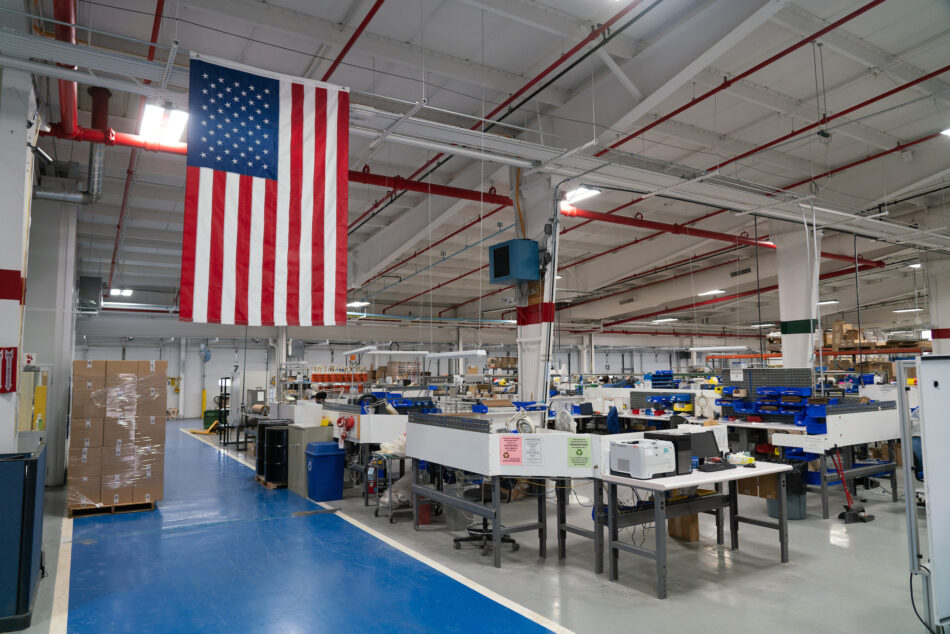
For nearly three years, many manufacturers in the U.S. have been operating at a disadvantage to their foreign competitors due to the lack of a Miscellaneous Tariff Bill. And that needs to change, the NAM told Congress yesterday.
What’s going on: The NAM, along with more than 200 manufacturers and industry partners, urged key members of the House and Senate to pass the MTB as soon as possible this year.
- The measure—which expired at the end of 2020—temporarily eliminates or reduces tariffs on products not readily available in the U.S. and is typically renewed by Congress every few years on a bipartisan basis.
- The previous MTB was passed unanimously in 2018, and in June 2021, the Senate approved an amendment including it and other trade provisions by a strong bipartisan vote of 91–4.
Why it’s important: Since the last MTB’s expiration, manufacturers and other businesses have paid more than $1.4 billion in anticompetitive tariffs to get items they are unable to source in the U.S., according to an NAM analysis.
- In addition to incentivizing overseas manufacturing and costing jobs, the additional expenses are harming local economies and American taxpayers by increasing the prices on manufactured goods.
What should be done: “Congress can reverse course by passing the MTB through 2026 with meaningful retroactivity and reauthorizing future MTB cycles without broad and arbitrary restrictions that would be difficult to implement,” the NAM and partner groups said.
- “Congressional passage of the MTB will spur growth: according to the U.S. International Trade Commission, tariff relief under the previous MTB boosted U.S. GDP annually by as much as $3.3 billion and output annually by as much as $6.3 billion.”
The last word: “If Congress is serious about supporting manufacturers and workers in the United States, they must prioritize the passage of the MTB by the end of this year,” said NAM Director of Trade Facilitation Policy Ali Aafedt.
NAM Hosts 2023 Manufacturing Legal Summit
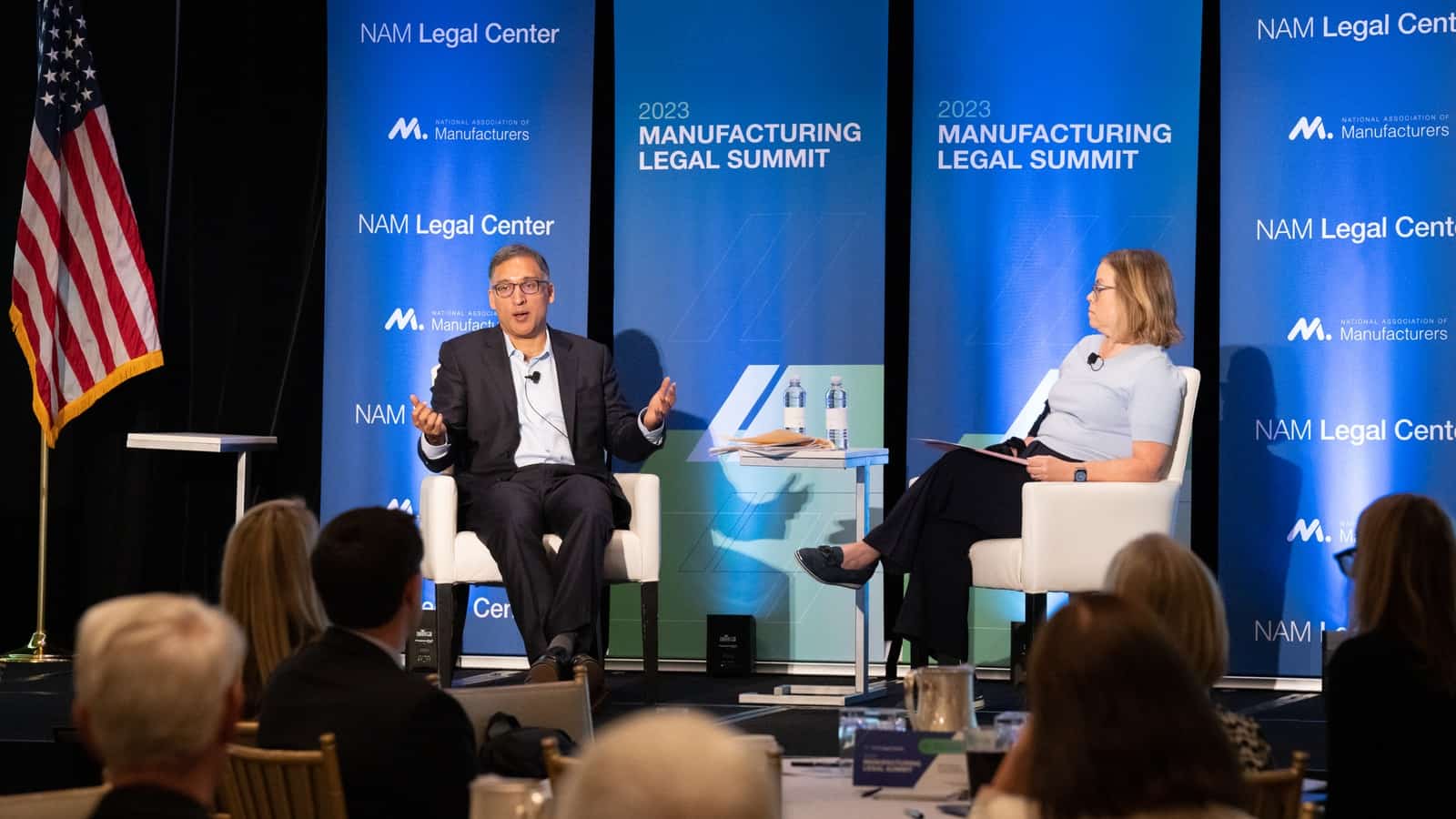
Every day, manufacturers face complex legal and regulatory challenges that can harm their companies’ bottom lines. Too often, in-house legal staff are forced to navigate this difficult and unpredictable climate alone.
That’s where the NAM’s Manufacturing Legal Summit comes in to provide support. Held on Nov. 6–7 in Washington, D.C., the second-annual Legal Summit brought together in-house counsel from manufacturing companies across the nation to share vital information and practical tools to address the ever-changing legal and regulatory landscape.
“From changes in the law to an increase in enforcement actions to an onslaught of new regulations, manufacturers are facing a more complicated legal environment than ever before,” said NAM Deputy General Counsel for Litigation Erica Klenicki. “Our summit offers the kind of practical legal tools manufacturers need to succeed—and a national network of manufacturing peers that doesn’t exist anywhere else.”
Exploring issues: The Legal Summit covered a range of topics, including the following:
- Supply chain integrity: A team of experts from the law firm Foley & Lardner (partners Greg Husisian, Elizabeth Haas and Marcos Carrasco Menchaca) and Aurorium General Counsel Fernanda Beraldi discussed new supply chain integrity requirements, helping participants understand shifting rules and providing practical solutions to identify and manage risks.
- The NLRB: The priorities and actions of the current National Labor Relations Board present a significant pro-labor shift. Fisher Phillips Managing Partners Steve Mitchell and Steve Bernstein offered context and a critical look ahead.
- Data privacy: Husch Blackwell Partner David Stauss laid out the trends and implications of privacy law at the state and federal level.
- Cyber risk: In a presentation from Baldwin Risk Partners National Director of Cyber Product Emily Perry Short, attendees learned about the impact of cyberattacks and regulations—and what manufacturers need to know to keep their businesses safe.
- SCOTUS: A conversation between former Acting Solicitor General of the United States Neal Katyal and NAM Chief Legal Officer Linda Kelly offered a behind-the-scenes look at oral advocacy before the U.S. Supreme Court and laid out the stakes for manufacturers in the Court’s upcoming term.
- Product liability: Participants learned about best practices for navigating adverse events in regulated industries from a panel comprised of former Commissioner of the Consumer Product Safety Commission Joseph Mohorovic, two seasoned products liability attorneys, Steve Karg and Carol Welborn Reisman, and an in-house counsel at GE Appliances, Jeff Sefton.
- Ethics: Tom Spahn, counsel for McGuireWoods, led an interactive program addressing ethical issues for in-house counsel.
Creating a network: In addition to providing practical knowledge and real-world strategies, the Legal Summit offered manufacturing counsel the opportunity to meet one another, exchange ideas and develop a strong network.
- “General counsels offices for manufacturers are spread out across the country, and so rarely have a chance to convene as a group,” said Michael Tilghman, litigation counsel at the NAM. “That’s something that’s very unique to this summit, which is a great opportunity to build supportive networks.”
Making waves: Participants shared positive reactions to the program.
- “The feedback shared by my team was overwhelmingly positive and complimentary of the job your (small, but mighty) team did in putting together the agenda and speakers,” said Jason Brown, vice president, general counsel and secretary of GE Appliances. “Kudos to [the NAM Legal Center] and those behind the scenes that supported you in this effort. It is already on our calendar for next year.”
The last word: “The NAM Legal Center is an incredible resource and an important part of navigating the current climate,” said Klenicki. “I hope that participants come away from this summit not only with new tools and understanding, but with the knowledge and appreciation that the NAM Legal Center has their back.”
NAM Pushes Back on Restrictive Chemical Rule

The Environmental Protection Agency is considering an effective ban of a chemical compound called ethylene oxide. However, abruptly eliminating the chemical from use could have profound negative consequences for manufacturers and make modern life much more difficult.
The background: Ethylene oxide is a chemical used in a wide range of products, from textiles to plastics to antifreeze. It’s also used to sterilize certain medical devices—and in some cases, it’s the only chemical effective for that purpose.
The problem: The EPA is considering a new regulation that would set the acceptable levels of the chemical in the atmosphere so low that it amounts to a ban on the compound.
- “If you took a monitor outside in any U.S. city center, where no manufacturing production occurs, the level of ethylene oxide would be higher than the level the EPA is proposing,” said NAM Vice President of Domestic Policy Brandon Farris.
- “So anywhere that manufactures or uses ethylene oxide would be above the level they’re suggesting. The EPA is effectively banning it by creating a level that’s so low it can’t possibly be met.”
The impact: Because there are no current substitutes for some uses of ethylene oxide, a de facto ban would have immediate and serious impacts.
- “If this rule is finalized, a large number of medical devices could no longer be sterilized, and a lot of items that are relied on for modern life, such as textiles, plastics, household cleaners and adhesives, could not be produced in their current form,” said Farris. “If the EPA moves forward with this proposal, there will be no alternatives for the critical uses of this compound.”
The timeline: The final rule is expected to be released in the next few months. If the EPA chooses to finalize the rule in its current form—which would create a de facto ban on production and usage—manufacturers would be required to find a replacement for the chemical immediately. Developing a replacement in such a short amount of time will be difficult if not impossible.
- “One of the problems with creating a regulatory timeline for replacement is that science doesn’t work on an agency’s timeframe,” said Farris. “With no off-the-shelf substitute, it could take years to replace essential products, if we’re able to replace them at all.”
Our actions: The NAM is pushing back aggressively on this rule and raising manufacturers’ concerns with the White House, Congress and the EPA.
The bottom line: “This as proposed is a bad regulation,” said Farris. “Policymakers need to go back to the drawing board, recognize the critical applications of ethylene oxide and develop a proposal that is grounded in reality.”
Learn more about the NAM’s efforts to fight regulatory overreach here.
NAM Pushes Back on Restrictive Chemical Rule

The Environmental Protection Agency is considering an effective ban of a chemical compound called ethylene oxide. However, abruptly eliminating the chemical from use could have profound negative consequences for manufacturers and make modern life much more difficult.
The background: Ethylene oxide is a chemical used in a wide range of products, from textiles to plastics to antifreeze. It’s also used to sterilize certain medical devices—and in some cases, it’s the only chemical effective for that purpose.
The problem: The EPA is considering a new regulation that would set the acceptable levels of the chemical in the atmosphere so low that it amounts to a ban on the compound.
- “If you took a monitor outside in any U.S. city center, where no manufacturing production occurs, the level of ethylene oxide would be higher than the level the EPA is proposing,” said NAM Vice President of Domestic Policy Brandon Farris.
- “So anywhere that manufactures or uses ethylene oxide would be above the level they’re suggesting. The EPA is effectively banning it by creating a level that’s so low it can’t possibly be met.”
The impact: Because there are no current substitutes for some uses of ethylene oxide, a de facto ban would have immediate and serious impacts.
- “If this rule is finalized, a large number of medical devices could no longer be sterilized, and a lot of items that are relied on for modern life, such as textiles, plastics, household cleaners and adhesives, could not be produced in their current form,” said Farris. “If the EPA moves forward with this proposal, there will be no alternatives for the critical uses of this compound.”
The timeline: The final rule is expected to be released in the next few months. If the EPA chooses to finalize the rule in its current form—which would create a de facto ban on production and usage—manufacturers would be required to find a replacement for the chemical immediately. Developing a replacement in such a short amount of time will be difficult if not impossible.
Read the full story here.
How Manufacturers Can Benefit from Military Talent
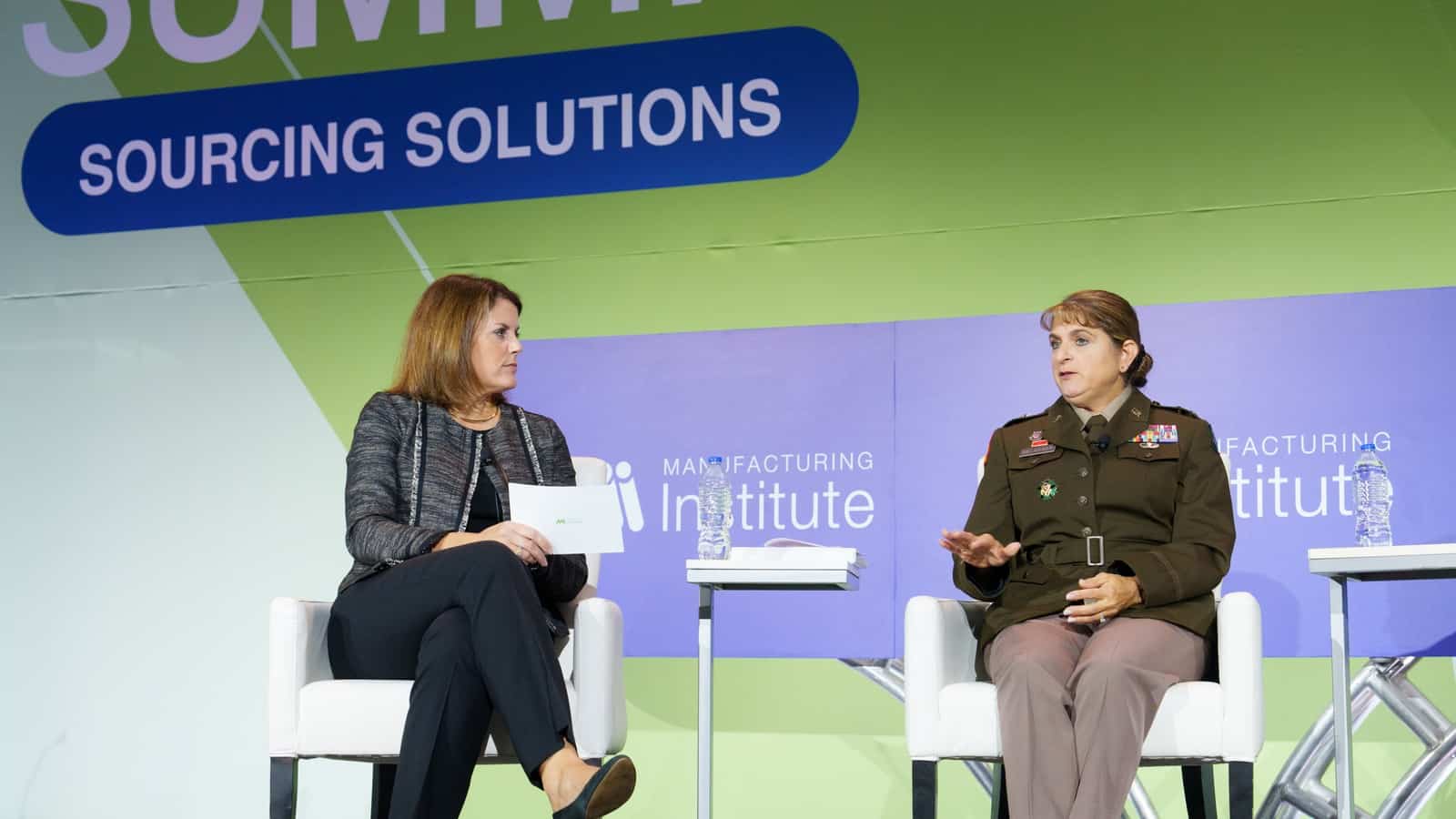
Looking for committed, disciplined employees to add to your workforce? In honor of Veterans Day, we’ll be highlighting how recruiting military talent—whether transitioning service members, veterans, National Guard members, reservists or military spouses—can help manufacturers address structural workforce shortages.
A productive match: At the Manufacturing Institute’s annual Workforce Summit in October, Maj. Gen. Kris A. Belanger, commanding general of the 99th Readiness Division, Army Reserve, spoke about the results manufacturers and military talent can achieve by working together.
- “The military offers diverse talent, very diverse. There are lots of ways that our training, roles and responsibilities overlap with those in manufacturing. Hiring military talent is a win–win situation,” she emphasized.
Making connections: During the “Leveraging Military Talent to Source an Essential Workforce” breakout session, MI National Director of Military and Veterans Initiatives Amy Thomas discussed how manufacturers can widen talent pipelines to include those affiliated with the military.
- “The Heroes MAKE American initiative trains and support military talent as they find a new career that utilizes their military training and experiences,” she said.
- “Since 2018, Heroes MAKE America has issued more than 6,000 industry-recognized certifications, achieved a 90% placement rate among graduates in more than 350 companies in 48 states and has shared information about manufacturing careers with more than 12 million individuals from the greater military community through social media, [Department of Veterans Affairs] newsletters and virtual and in-person industry events,” she continued.
Dive deeper: In addition to the Workforce Summit sessions, the MI held a Solution Series workshop in July to help manufacturers connect with military talent. The workshop offered manufacturers practical, actionable advice.
- For example, manufacturers should make sure the requirements listed in position descriptions are truly required for successful fulfillment of that role’s responsibilities, so that candidates coming from nontraditional backgrounds (such as military service) know they are welcome to apply.
- Companies should also make sure they know what military ranks and designations mean in terms of skills. They can go to the Civilian Leadership Equivalency Handout for guidance.
- For more tips, check out the MI’s Top 10 Solutions to Connect with Military-Affiliated Talent.
The last word: In conversation with Maj. Gen. Belanger, MI President and Executive Director Carolyn Lee noted, “With nearly 200,000 service members transitioning out of the military each year, the MI realized this was an opportunity to tap into that talent pool, teach them about manufacturing and bring them into our industry. That’s what makes our HMA program so exciting. We’re building those connections and providing those solutions.”
Get involved: Interested in learning more? Join the HMA team on Nov. 20 from 3:30 p.m. to 4:30 p.m. EST to learn how manufacturers can get involved in the program and benefit from this talent pool.
Thermo Fisher Scientific Opens Doors—and Career Paths—to Students on MFG Day
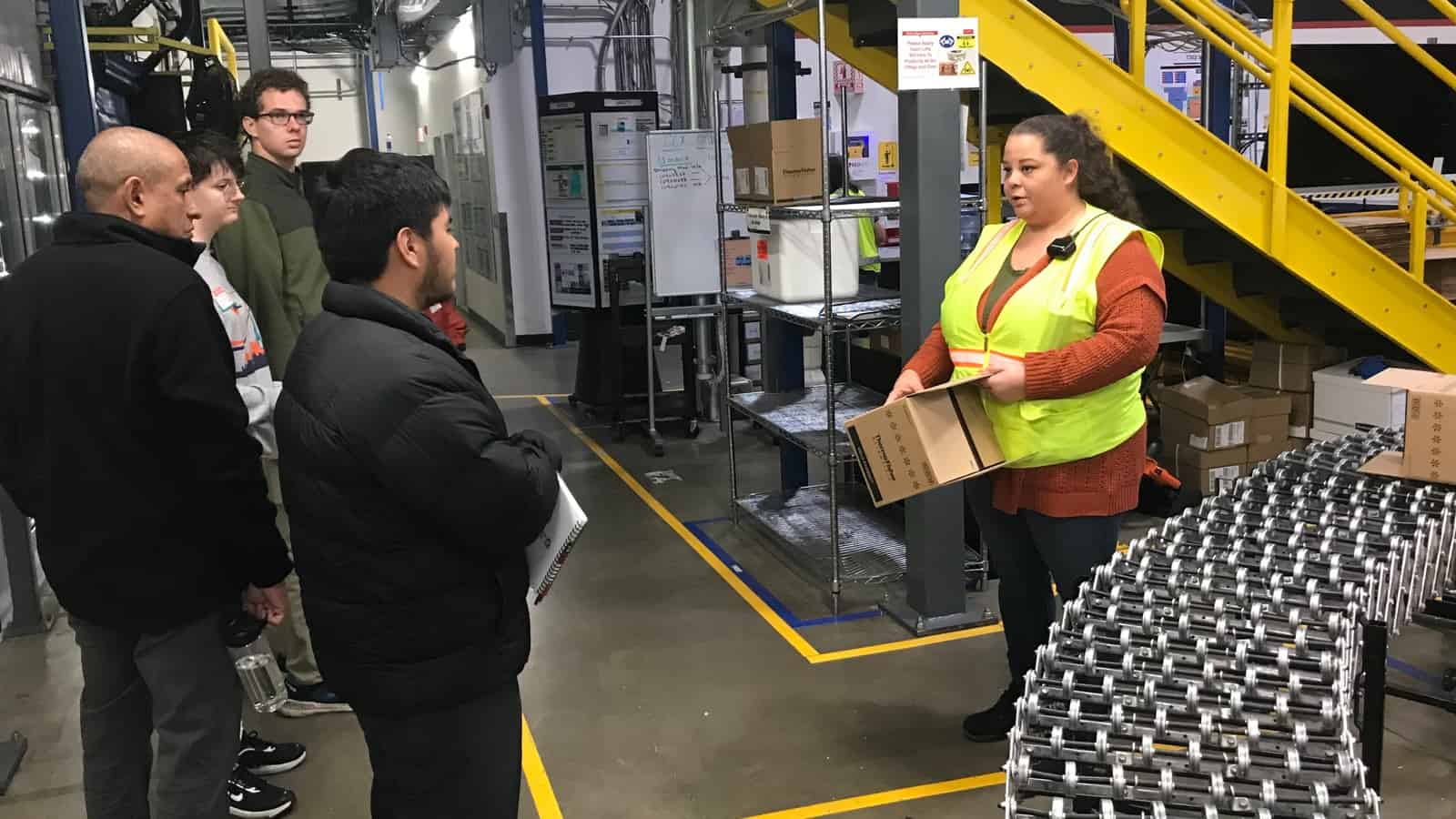
If you’re a jobseeker, Thermo Fisher Scientific wants you to know there are a plethora of job opportunities available at the company whether you have a science or engineering background or not.
At a well-attended MFG Day event for college students at its Frederick, Maryland, campus in October, both attendees and current employees said they were amazed to learn of the wide array of positions available at Thermo Fisher, a maker of life-sciences solutions and equipment.
Choose your own (career) adventure: “There’s a lot of opportunities here,” said Jude Ankrah, a cyber security engineer at the company’s Frederick location and one of the MFG Day’s event ambassadors, who helped lead student tours. “You can … make your own opportunities. There’s so much [internal] career movement. And it’s so flexible.”
- The MFG Day event drew about 60 students from four local colleges. It consisted of tours of the site’s distribution center, research-and-development cell biology building and corporate infrastructure and security center.
- Juan Argueta, who is working toward a cybersecurity degree at Frederick Community College, said he hadn’t expected the life-sciences giant to need people with his expertise.
- “I found out about it at school. I checked [the website], and there are actually a lot of openings in cybersecurity here,” Argueta told the NAM. “So I decided to come. There are so many great benefits [at Thermo Fisher]—including tuition reimbursement—for employees.”
Science not required: It’s a widely held misconception that people working at Thermo Fisher are all scientists and engineers, said Lisa Sweeney-Walker, senior executive assistant to Chief Scientific Officer Dr. Karen Nelson.
- “You don’t have to have a Ph.D. [or even] a science background” to get hired at Thermo Fisher, she said. “We have human resources, we have warehousing positions, we have other things.”
- In fact, the Frederick campus’s largest number of job openings is in manufacturing and distribution, said Frederick Site Leader and Senior Director of Manufacturing Operations Keith Howell, who spoke before the site tour. “We need both college-educated and non [degree-holding] hires,” he said.
Great strides: Thermo Fisher is doing some amazing things in science—and MFG Day attendees were able to watch some of its operations through interior windows at the R&D cell biology building.
- There, chemists are working to create “shells” for the next mRNA vaccines, Thermo Fisher Director of R&D David Kuninger told event attendees.
- Scientists at the company—who developed many of the tools involved in CAR T-cell therapy, a cell-based treatment technique in which a patient’s own T-cells are “programmed” in a lab to find and fight cancer cells—are now engineering an immune cell to fight cancer, he continued.
A path at Thermo Fisher: Regardless of your career interests, you’re likely to be able to pursue them at Thermo Fisher, said Shayne Boucher, a staff scientist in cell and gene therapy at the company.
- “Everyone has their own unique path,” he told the students. “There is an opportunity here to find out what works for you.”
